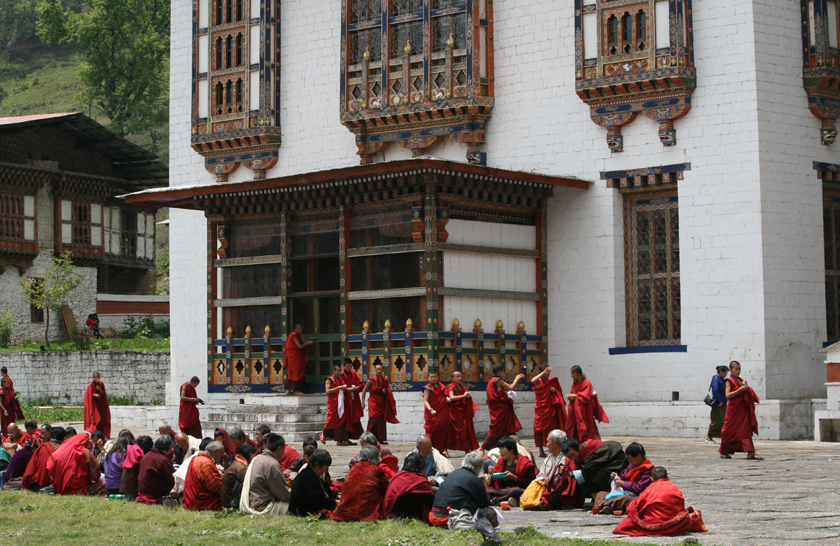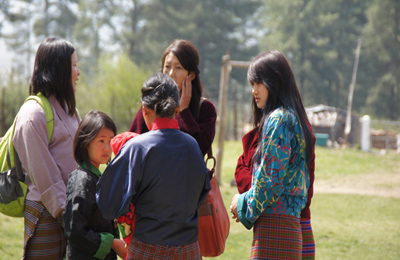
The Charm of visiting Bhutan
Our journey took us through five of the six main Dzonghags (districts) of Western Bhutan – Punakha, Wangdue Phodrang, Thimpu, Unemployment and Ha. All are located in valleys ranging from 1306 – 2700 m.
We first arrived in Punakha and found the fortress surrounded by jacaranda trees in full bloom. This may arguably be the most magnificent district in the nation. We walked into three courtyards that had walls lined with murals detailing the teachings of Buddhism. Sherab and Jatsho, our Bhutanese guides, explained the significance of the panels. Samsara – the wheel of existence, the life and marvels of Prince Siddhartha and his transition to Lord Buddha, the incarnations of the great masters and their triumph in the conquering of demons.
Nearby Wangdue Phodrang offered refuge by a river and the chance to visit the temple of the Divine Madman whose feats are immortalized in phallic symbols painted on the exterior of the houses we pass. We zig-zaged our way through newly planted rice paddies to get to the temple.
As we near the capital district Thimpu, we cross the Dochula Pass where prayer flags and 108 stupas mark the 3111 m boundary between the adjoining districts. Today it is too cloudy to see the snow-capped peaks and for the first time since leaving Canada one month ago the temperature is colder than I prepared for. On arrival, I see that Thimpu had grown drastically since my first visit 15 years ago. It is a largish city now with 100,000 plus residents. New hotels, cafés and souvenir shops extend a great distance. Still so many of the industries are cottage scale. We visit a paper-making centre and a weaving centre where the intricacies of hand-making skills are exemplified. Some of the women’s traditional skirt in process of completion at the weaving centre will take another 10 months to finish. The price tag reflects the workmanship at $ 1700 - $ 2500 USD per piece.
Next stop is the Paro Valley. Some of my travel mates, including myself, are quite winded here even though the altitude is 700 meters lower than two of the locations visited earlier. The experience of travelling across some of the most breathtakingly beautiful peaks of the Himalayan range, and then dipping into its stunning valleys was exhilarating and sometimes the changes in altitude could be felt.
 We walked from the National Museum (well worth the visit) to the Paro Dzong (fortress) and again got a chance to learn more about the religious passion of the nation. We have entered into the 5th month of the lunar calendar during which time the entire Nation will be earning extra merit at their local temples by praying and making offerings. We witnessed monks making cakes for the altar and chanting in the temples as they have done in the same places for between 4 - 14 centuries. The sound of drums, long horns and short horns emanated from the temples, so of which we were permitted inside while the rituals were occurring.
We walked from the National Museum (well worth the visit) to the Paro Dzong (fortress) and again got a chance to learn more about the religious passion of the nation. We have entered into the 5th month of the lunar calendar during which time the entire Nation will be earning extra merit at their local temples by praying and making offerings. We witnessed monks making cakes for the altar and chanting in the temples as they have done in the same places for between 4 - 14 centuries. The sound of drums, long horns and short horns emanated from the temples, so of which we were permitted inside while the rituals were occurring.
Paro is home to the countries only international airport. There is only one airline flying in and out – Druk Air, the national carrier of Bhutan. From our hotel we watched planes take off and land in the early morning when the lift was ideal for flight. Planes weaved between the green hills and rose towards the higher mountains that were visible when the clouds parted.
A day trip brought us to the most Western district – Ha, which was restricted to tourists until 2002. It borders India and Tibet and, as in many border regions, can be somewhat instable. To reach Ha, we crossed the highest pass, Chelala, at 3700m. Most of the travelers we met here had arrived by road from India, taking advantage of being admitted without a visa requirement or the typical $250 USD per diem fee. It’s still expensive to come this route, but the road work is provided by India in aid to Bhutan – part humanitarian and part an exchange for lands annexed to India in the 1950’s. The Bhutanese seemed grateful for this infrastructure support provided by their closest ally.
On this journey, I have been shocked at the limited number of visitors from Europe and North America. We have only encountered a few groups and a handful of single travelers in the 2 ½ weeks we have been travelling across the country. And, no matter the group size, all are led by a Bhutanese guide. Thankfully we are certain that we had the best with us.
10 Tips for travel to Bhutan
- Read travel information from the Bhutan Tourism department before you go.
- Consider flying in one way and travelling by road the other way via India (2 spots in Assam) or Sikkim (1 entry point).
- Watch the TED talk by Tshering Tobgay, Prime Minster of BhutanWatch the TED talk by Tshering Tobgay, Prime Minster of Bhutan
- Stay an extra day. No matter how long you stay – you always feel like you could have used just one more day.
- Include some bird-watching and wildlife viewing in one of the preserved forests. And don’t forget to bring binoculars.
- Choden, Kunzang; The Circle of Karma, (a novel written by one of the most famous of Bhutan’s writers; interesting in terms of day to day life of Bhutan, and gender issues) (2005)
- Das, Britta, Butter Tea at Sunrise: A year in the Bhutan Himalaya (2007)
- Drexler, Madeline. A splendid isolation: Lessons in happiness from the Kingdom of Bhutan (2014)
- Grimmett, Richard, Inskipp, Carol, & Inskipp, Tim; Birds of the India Subcontinent (2010)
- Pommaret, Francoise Bhutan: Himalayan Mountain Kingdom (2009)
- Zeppa, Jamie: Beyond the Sky and the Earth: A journey to Bhutan (2000)
- Writersofbhutan.com Website of poems and Bhutanese literature
- Give yourself at least two days to adjust to the high altitude if flying into Paro.
- Travel from February to May, or October to November.
- Include at least one-day hike. Some of the best one-day hikes I have experience with are Ha Valley, Paro Valley, Valley of the Black-necked cranes, the Yonkala/Limenthang Road, and Trashigang to Rangshikar Village. There are of course hundreds of others.
- Hotels are pretty scarce, so the earlier you book the better your chances. Some with the best guides and the Visa processing time. Bhutan is not a ‘last minute’ destination.
